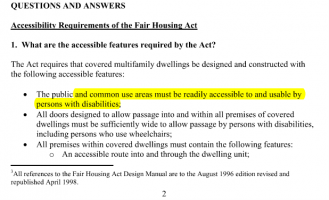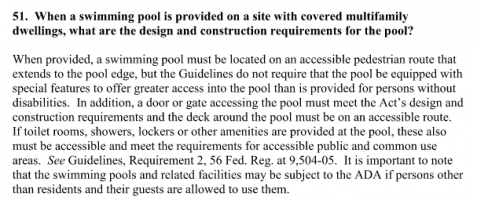-
Welcome to The Building Code Forum
Your premier resource for building code knowledge.
This forum remains free to the public thanks to the generous support of our Sawhorse Members and Corporate Sponsors. Their contributions help keep this community thriving and accessible.
Want enhanced access to expert discussions and exclusive features? Learn more about the benefits here.
Ready to upgrade? Log in and upgrade now.
You are using an out of date browser. It may not display this or other websites correctly.
You should upgrade or use an alternative browser.
You should upgrade or use an alternative browser.
ADA as applied to R2 Condominium Pools
- Thread starter jar546
- Start date
Yikes
SAWHORSE
I see that this is an interpretation specific to Florida's state accessibility laws, and it concerns a multifamily development where the swimming pool is used only by residents and their guests, and not the public. But what about the Federal Fair Housing Act for Multifamily dwellings?
See excerpt below from the HUD/DOJ joint statement on the FHA:
https://www.fairhousingnc.org/wp-co...cessible-Design-Construction-Requirements.pdf


And here's the specifics for pools:

See excerpt below from the HUD/DOJ joint statement on the FHA:
https://www.fairhousingnc.org/wp-co...cessible-Design-Construction-Requirements.pdf


And here's the specifics for pools:

Last edited:
jar546
CBO
I personally believe that Florida does not take accessibility seriously and that the Florida Building Commission oversteps their boundaries.
Mr. Inspector
SAWHORSE
That's odd considering FL is god's waiting room.I personally believe that Florida does not take accessibility seriously and that the Florida Building Commission oversteps their boundaries.
mtlogcabin
SAWHORSE
It is also Satan's waiting roomThat's odd considering FL is god's waiting room.
mark handler
SAWHORSE
It also should be covered under the FAIR HOUSING ACT
The Fair Housing Act does not distinguish between different forms of ownership when determining whether a unit or building is covered. Condominiums are covered by the Fair Housing Act even if they are pre-sold as a shell and the interior is designed and constructed by the buyer.
The path of travel to and placement of site amenities, such as outside mailboxes, refuse disposal areas, swimming pools, clubhouses, and sports facilities should be given careful consideration early in the planning process. The intent of the Fair Housing Act is that people with disabilities be able to reach and use such amenities.
The swimming pool, picnic area, and playground are site amenities building and must be reachable by an entrance accessible route; in this example, a road and accessible parking are Careful Site Analysis and Building Placement in the not required since there is an Planning Stage of a Housing Development Makes accessible pedestrian route
The Fair Housing Act does not distinguish between different forms of ownership when determining whether a unit or building is covered. Condominiums are covered by the Fair Housing Act even if they are pre-sold as a shell and the interior is designed and constructed by the buyer.
The path of travel to and placement of site amenities, such as outside mailboxes, refuse disposal areas, swimming pools, clubhouses, and sports facilities should be given careful consideration early in the planning process. The intent of the Fair Housing Act is that people with disabilities be able to reach and use such amenities.
The swimming pool, picnic area, and playground are site amenities building and must be reachable by an entrance accessible route; in this example, a road and accessible parking are Careful Site Analysis and Building Placement in the not required since there is an Planning Stage of a Housing Development Makes accessible pedestrian route
tbz
SAWHORSE
I agree with Yikes on this, the interpretation is for the State's accessibilities code, as they have no standing to make a ruling on Federal ADA and their finding is in conflict with HUD requirements.
Thus, the simple ruling is, they are leaving it up to the Feds to deal with.
Thus, the simple ruling is, they are leaving it up to the Feds to deal with.
Jean Tessmer-HI
REGISTERED
The FHA 1991 Guidelines do not specify how to get in and out of the pool. Congress's intent for the FHA was to have it provide modest and reasonable accessiblility. They were worried that having residential muultifamily dwelling all required to be fully accessible would put the cost of housing out of reach of low to middle income families. They also did not want the dwellings to look different like it was just for wheelchair users. This is a brief summary of the intent of Congress did include the option for reasonable accomodations for individuals with disabilities just like any condo owner could redo their interior to suite what they want in their own home. Read the original FHA 1991 guidelines that contain the preamble commentary that discusses the legislative intent.
Jean Tessmer-HI
REGISTERED
In the 1991 FHA Guidelines with the preamble commentary, search for the words "modest" and "reasonable".
I took a brief look at the Florida Building, Accessibility (2010). I am in agreement with tbz and Yikes, because I don't think Florida can enforce a federal law by reference. They can enforce their own written statewide agreed and accepted accessibility code that can be sent to the DOJ to see if they deem it equivalent but only the DOJ can enforce the ADA. If you read the FHA statute which is the 1991 Guideline there is no scoping for how to access a pool for the multifamily development. From my reading of the FHA statute it only requires an accessible route to and from the pool area that also includes mail box areas.
Hello Jar,Read it for yourself and comment. It is not a short read but it is not a very long read either: (public information)
See attached PDF
I took a brief look at the Florida Building, Accessibility (2010). I am in agreement with tbz and Yikes, because I don't think Florida can enforce a federal law by reference. They can enforce their own written statewide agreed and accepted accessibility code that can be sent to the DOJ to see if they deem it equivalent but only the DOJ can enforce the ADA. If you read the FHA statute which is the 1991 Guideline there is no scoping for how to access a pool for the multifamily development. From my reading of the FHA statute it only requires an accessible route to and from the pool area that also includes mail box areas.
Jean Tessmer-HI
REGISTERED
Hello Jar -
Fair Housing Act - Rules and Regulations page 9487 left column 5th paragraph.
Department has decided not to change the specifications for recreational facilities, including swimming pools, as provided by the Option One guidelines, since there are no generally accepted standards covering such facilities. Thus, access to the pool area of a swimming facility is expected, but not specialized features for access into the pool (e.g., hoists, or ramps into the water).
Fair Housing Act - Rules and Regulations page 9487 left column 5th paragraph.
Department has decided not to change the specifications for recreational facilities, including swimming pools, as provided by the Option One guidelines, since there are no generally accepted standards covering such facilities. Thus, access to the pool area of a swimming facility is expected, but not specialized features for access into the pool (e.g., hoists, or ramps into the water).
ADAguy
REGISTERED
Local codes are "intended" to provide technical requirements for compliance with federal laws and shall not be less than accessible to people with disabilities, at least that is what GC 4450 in CA requires.
